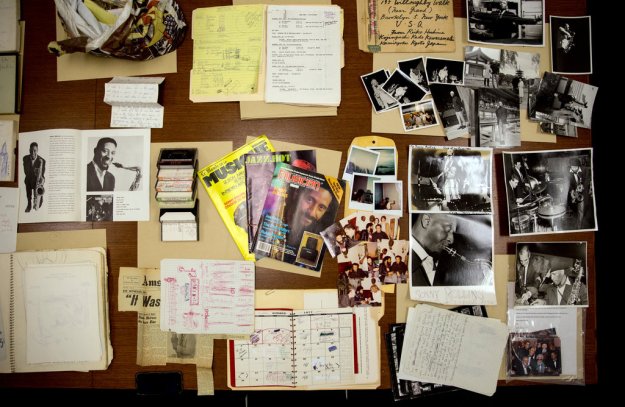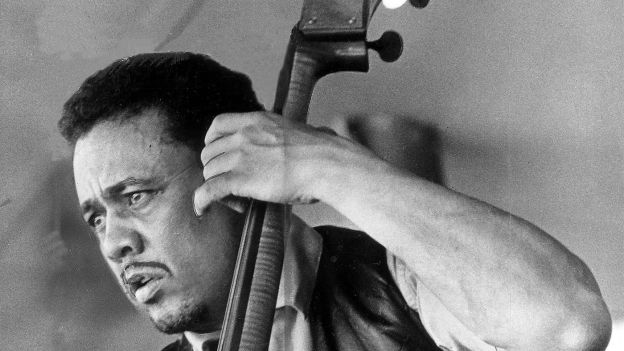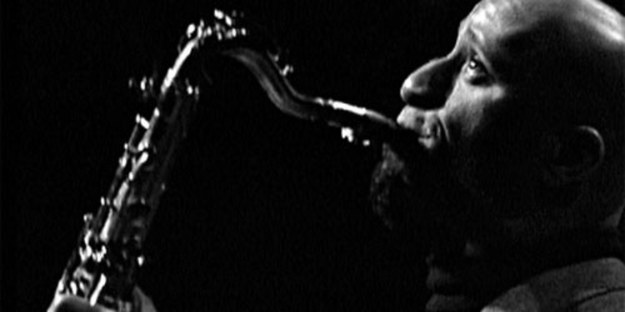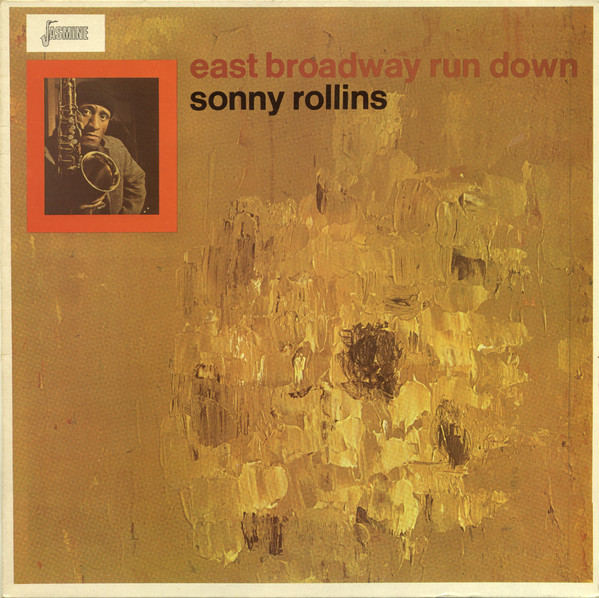
Photographs, notebooks, calendars, magazines and hundreds of recordings are part of the archive.
“The saxophonist Sonny Rollins, perhaps jazz’s most respected living improviser, is also one of its most relentless seekers. But that’s well known; what’s not as widely recognized is the diversity — and the depth — of his inquiry. Yes, there’s his herculean practice regimen (upward of eight hours a day, even into middle age) and the yearslong sabbaticals he took from performing to hone his craft. But Mr. Rollins, 86, has also maintained a vigorous, syncretic spiritual practice, and he has written hundreds of pages of personal notes over the years — reflecting on music technique and the music business and expressing social laments. He even started writing an instructional saxophone book but dropped that project. …”
NY Times (Video)
Tag Archives: Sonny Rollins
Dizzy Gillespie, Sonny Stitt and Sonny Rollins: Sonny Side Up (1957), Duets (1958)

“… Dizzy Gillespie joined the Granz roster in 1953, and he was the catalyst for many summit meetings, including superb albums with Stan Getz, Roy Eldridge and Oscar Peterson. However, there is little doubt that the greatest of these recordings were the two 1957 albums with Sonny Rollins and Sonny Stitt, issued as ‘Sonny Side Up‘ and ‘Duets‘. The pairing of Rollins and Stitt was highly inspired. More important than their common nicknames (and the punning album title), tenor saxophonists Rollins and Stitt were both influenced by Charlie Parker, but each took a vastly different approach to improvisation. Stitt transferred Parker’s white-hot intensity to the tenor after several fans and critics pointed out the tonal similarity of their alto sounds. Rollins was a more thoughtful player who expanded the vocabulary of bop improvisation by incorporating thematic elements into his solos and by experimenting with different melodic shapes and unusual phrase lengths. …”
Jazz History Online
Discogs (Video) Sonny Side Up, Duets (Video)
W – Sonny Side Up, W – Duets
YouTube: Sonny Side Up 37:41, Duets 44:46

Sonny Rollins – Way Out West (1957)

“Concord Music has remastered and reissued a set of jazz landmarks from the Original Jazz Classics catalogue – with highlights including Thelonious Monk’s short but sensational relationship with John Coltrane, Art Pepper’s encounter with Miles Davis’s 1957 rhythm section, and Dave Brubeck’s pre-Take Five wakeup call, Jazz at Oberlin. But Sonny Rollins’s 1957 Way Out West (whose cover features Rollins dressed in a suit, tie, gunbelt and 10-gallon hat against a backdrop of cactuses and cattle bones) is one of the most influential. Hearing it was Courtney Pine’s induction into jazz sax, and many others tell the same story. It comes from a prolific period for Rollins, and features Ray Brown on bass and the west coast drummer Shelly Manne. The cover shot and some of the titles (I’m an Old Cowhand, Wagon Wheels) suggest a send-up, but Rollins has always loved conjuring rich narratives from cheesy material, and after the intro to Cowhand he’s off on one of his odysseys of seamless runs and biting accents over Brown’s driving pulse. He’s luxuriously wayward on Duke Ellington’s Solitude and swaggeringly productive on the uptempo Come, Gone – the album’s standout episode, represented here in two takes. Marc Myers’s new liner notes don’t add much, but if you squint you can read Lester Koenig’s absorbing original for the 1957 Contemporary Records release.”
Guardian
Pitchfork
W – Way Out West
Discogs (Video)
YouTube: Way Out West 43:22
A Night at the Village Vanguard – Sonny Rollins (1957)

“Sonny Rollins’ name met the marquee of The Village Vanguard in the fall of 1957, and by November 3rd the saxophonist had honed his group to basic rudiments and figured out exactly what he wanted to do. With drummers Elvin Jones and Pete La Roca and bassists Wilbur Ware and Donald Bailey, he delivered one of jazz’s core documents, the undyingly superlative A Night at the Village Vanguard. According to Leonard Feather’s liner notes for the original 6-track LP documentation of Sonny Rollins’ ’57 Vanguard stand, the saxophonist first hit the stage for a week with a quintet including trumpet and piano. Not happy with the results, he ditched the other horn and grabbed a new rhythm section for week two. Dissatisfied with the quartet lineup as well, Rollins then decided upon a sax-bass-drums trio. …”
Graded on a Curve: Sonny Rollins, A Night at the Village Vanguard
NPR: Sonny Rollins Spent A Mythical ‘Night at the Village Vanguard’ 60 Years Ago Today (Video)
W – A Night at the Village Vanguard
Discogs (Video)
YouTube: A Night At The Village Vanguard – Side 1, Side 2

Newk’s Time – Sonny Rollins (1959)

The 1959 Project – “Sonny Rollins’ third album for Blue Note, called Newk’s Time, was on record store shelves in early March 1959. It had been recorded in 1957, with Wynton Kelly, Doug Watkins and Philly Joe Jones at Rudy Van Gelder’s Hackensack studio. ‘The record, as I have said, is simply a record of how Rollins felt on one particular afternoon,’ wrote Joe Goldberg in the liner notes. ‘It is a measure of his achievements that such fleeting impressions can have this much significance.’ …”
The 1959 Project
All About Jazz
W – Newk’s Time
Discogs (Video)
amazon, iTunes
YouTube: Newk’s Time 34:12
Jazz at 100 Hour 47: The Experimentalists – Charles Mingus, Sonny Rollins, and John Coltrane (1956 – 1959)

Charles Mingus
“In his book Hard Bop: Jazz and Black Music 1955-1965, David Rosenthal outlines a group of musicians within the hard bop idiom that he identifies as ‘experimentalists’, describing them as ‘…consciously trying to expand jazz’s structural and technical boundaries: for instance, pianist Andrew Hill, Sonny Rollins, and John Coltrane prior to his 1965 record Ascension. This category would also include Thelonious Monk and Charles Mingus, whose playing and compositions were at once experimental and reminiscent of the moods and forms of earlier black music, including jazz of the 1920s and 1930s. Mingus, for example, composed and recorded ‘My Jelly Roll Soul,’ which is simultaneously a tribute to Jelly Roll Morton and a successful attempt to transmute and reformulate Morton’s compositional style in modern jazz terms… These musicians, by influencing and challenging [the other hard bop musicians], kept hard bop from stagnation. Even at their most volcanic, their performances were pervaded by a sense of thoughtful searching.’ …”
WTJU 91.1FM
All About Jazz (Audio)
Mixcloud (Audio)
Jazz Icons: Sonny Rollins Live in ’65 & ’68

“Age is inescapable. When you’re young, no matter how brilliant or talented, you are hampered by a lack of perspective. With time comes wisdom, but gone are other ineffable qualities. If you are lucky, in the middle somewhere there is a golden period of confluence. In jazz, these truisms are embodied by the giant of the tenor saxophone, Sonny Rollins. Born in 1930, Rollins is in every respect the last of a generation of jazz titans—a contemporary of and collaborator with the likes of Miles Davis, John Coltrane, Dizzy Gillespie and Clifford Brown. To this day, Rollins is considered one the greatest living saxophonists. Indeed, he is often hailed as the greatest musical improviser on the planet, a man whose horn is a pure extension of his heart. But no discussion of Sonny Rollins can avoid the question of how time has changed his art. Conveniently for critics, Rollins himself has chopped his performing life into obvious chapters. In the early ’50s he was a valued sideman (with Davis and Monk, among others) and a promising composer. His emergence as a leader in 1956 was definitive: he recorded the all-time classic Saxophone Colossus at 25 and then pioneered the piano-less saxophone trio shortly thereafter. By 1959, however, he went into a self-imposed sabbatical period, famously practicing nightly on the Williamsburg Bridge to regain his sense of musical purpose. He returned with a newly adventurous spirit—stirring it up with a guitar-based band, Latin music, the avant-garde—only to ‘retire’ again around 1970. His return in ’72 brought an engagement with pop rhythms and textures, but also a fascination with solo saxophone playing. …”
Jazz Icons: Sonny Rollins Live in ’65 & ’68
YouTube: Jazz Icons: Sonny Rollins Live in ’65 & ’68 1:26:47

Sonny Rollins – East Broadway Run Down (1966)

“Around the ten-minute mark of the title track, things get very interesting indeed — moody and spooky as Jimmy Garrison hangs on a single note, making his bass throb along while Elvin Jones widens the space and fires drum and cymbal hits in all directions. Coming off bass and drum solos that never seem to fit anywhere in the piece, it’s a supreme moment of tension-building, one that gets repeated after Rollins and trumpeter Freddie Hubbard restate the theme in unison. This is the sound of Rollins‘ group working in unity. For much of ‘East Broadway Run Down,’ though, the rhythm section is off doing their thing, usually together, while Rollins meanders about in limbo, seemingly trying to figure out what it is that he should be doing. That Rollins was having an off day for this recording is a suspicion that’s strengthened by Hubbard‘s part — where Rollins is wandering, Hubbard is charging ahead, focused and tight, fitting with the rhythm section, keeping the tension up. …”
allmusic (Audio)
New York Mag: When Sonny Gets Blue
W – East Broadway Run Down
Discogs (Video)
amazon, iTunes
YouTube: East Broadway Run Down ( Full Album )